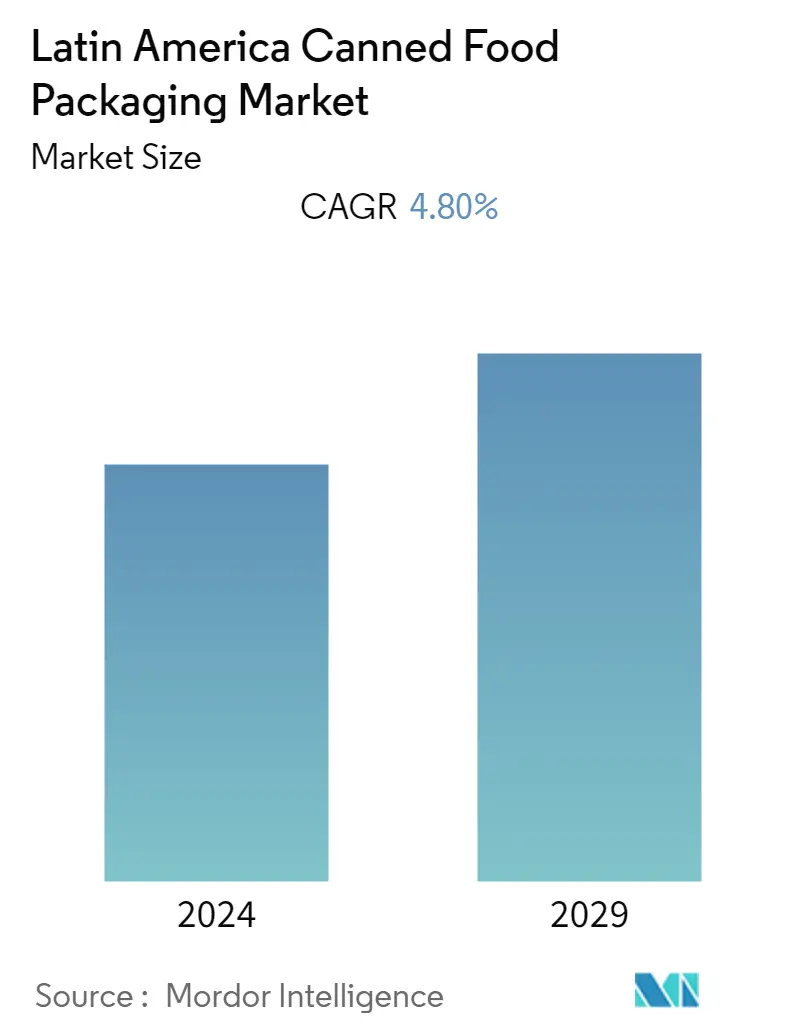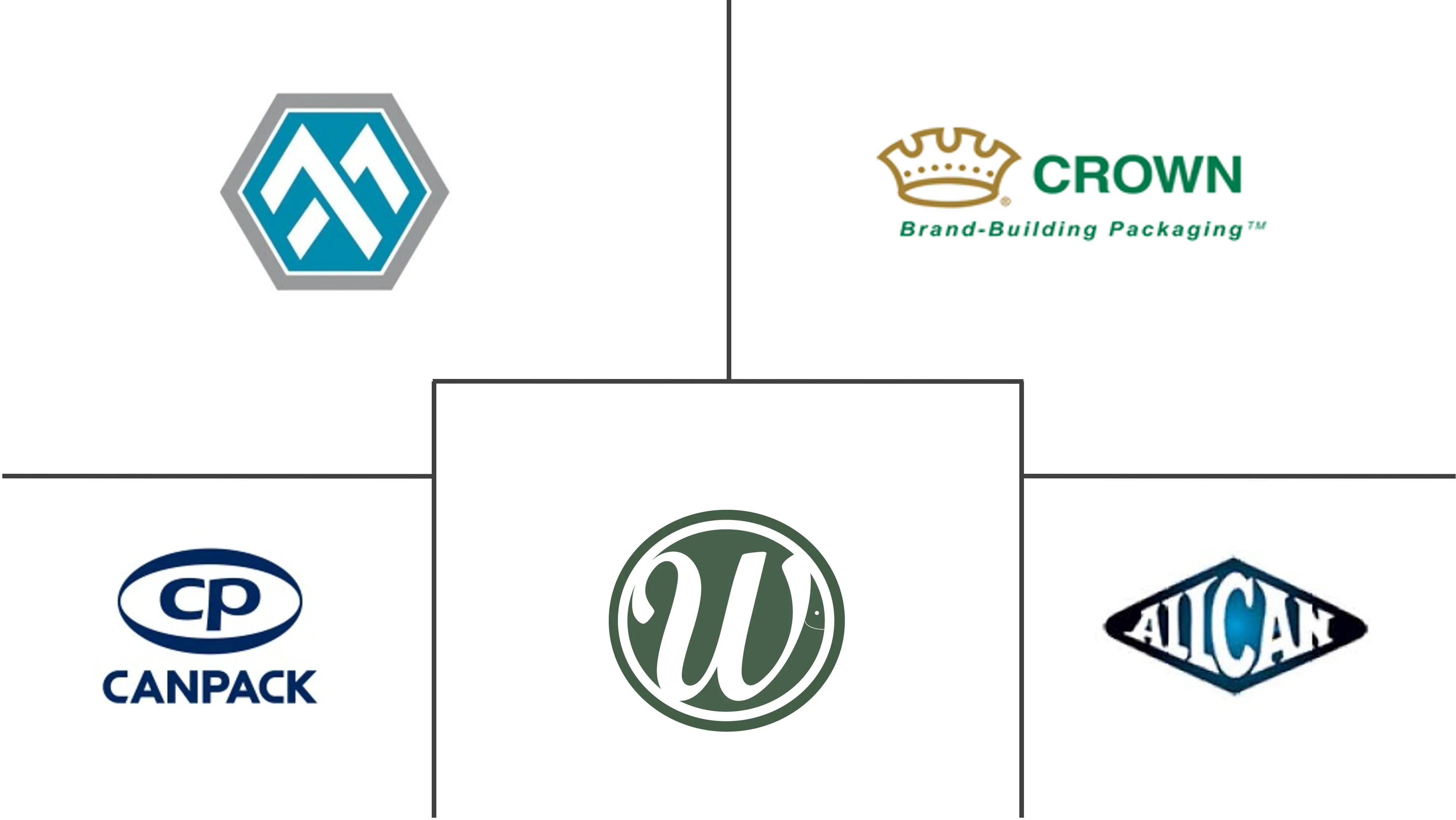Market Size of Latin America Canned Food Packaging Industry

| Study Period | 2019 - 2029 |
| Base Year For Estimation | 2023 |
| Forecast Data Period | 2024 - 2029 |
| Historical Data Period | 2019 - 2022 |
| CAGR | 4.80 % |
| Market Concentration | Medium |
Major Players
*Disclaimer: Major Players sorted in no particular order |
Latin America Canned Food Packaging Market Analysis
The Latin America Canned Food Packaging Market will register a CAGR of 4.8% during the forecast period. Because of an expansion in the disposable income and change in food inclinations, numerous consumers are leaning toward canned nourishments, which will play a role in expanding their interest, thus enlarging canned food market development, along with Increasing consumption of pre-packaged food is expected to drive the growth of the market.
- As one of the Major reasons which are leading to the surge in popularity of canned food is the rising trend of a busy, eventful life, especially among the millennium population, which has prompted the market to a significant level. Increasing workload and time constraints have led to the adoption of ready-to-eat packed and canned food consumption to save time and energy.
- Packaging for canned food shields the product from the elements and outside stimuli like heat and pollution, preventing spoilage. This packaging provides greater security and a longer product shelf life. Perishable food items can be inexpensive and preserved with slight flavor alteration via canning. Consequently, the expanding horticultural and seafood processing industries significantly demand this packaging.
- Food products in cans are also simple to travel and consume. Additionally, the market for canned food packaging has grown during observation due to the simple accessibility and rising supply of canned items.
- There was a shift in consumption patterns in the past decade, such as from a carbohydrate-rich diet to a protein-rich diet for better strength and stamina. Surging awareness regarding health & fitness and the availability of cheap fitness alternatives such as Zumba, Aerobics, and Yoga requires a balanced diet rich in nutrients like fibers, proteins, vitamins, minerals, and others. Canned food can store and provide these nutrients to consumers, making their meals healthier and safe.
- The COVID-19 pandemic has had a two-sided impact on the canned food market. While the nationwide lockdown resulted in stock-piling by retail households, the shutdown of the HoReCa industry decreased the market demand. The disturbed supply chain will likely hamper productivity and income suffrage across the region. It is probably expected to act as a restraint on the growth of the market studied.
Latin America Canned Food Packaging Industry Segmentation
Packaging canned food is essential for protecting food from contamination and preserving its sanitary value.
The Latin America Canned Food Packaging Market is segmented by Material (Metal, Steel, Aluminium), Product Type (Readymade Meals, Meat, Sea Food), and Country.
| By Material | |
| Metal | |
| Steel | |
| Aluminium | |
| Others |
| By Product Type | |
| Readymade Meals | |
| Meat | |
| Sea Food | |
| Fruits and Vegetables | |
| Others |
| By Country | |
| Brazil | |
| Mexico | |
| Argentina | |
| Rest of Latin America |
Latin America Canned Food Packaging Market Size Summary
The Latin America Canned Food Packaging Market is experiencing growth driven by changing consumer preferences and increased disposable income, which have led to a rising demand for canned foods. This trend is particularly pronounced among the millennial population, who favor the convenience of ready-to-eat meals due to their busy lifestyles. Canned food packaging plays a crucial role in preserving the quality and extending the shelf life of products by protecting them from external elements. The market is further bolstered by the expanding horticultural and seafood processing industries, which rely on this packaging to maintain the freshness and nutritional value of perishable items. The shift towards a protein-rich diet, influenced by health and fitness trends, has also contributed to the market's expansion, as canned foods offer a convenient source of essential nutrients.
The COVID-19 pandemic had a mixed impact on the canned food market, with initial stockpiling by consumers during lockdowns boosting retail sales, while the closure of the HoReCa industry led to decreased demand. The disruption of supply chains posed challenges, but the market has shown resilience with the rise of e-commerce as a key sales channel. The market is moderately consolidated, with major players like Ball Corporation and Crown Holdings Inc. expanding their operations and investing in sustainable packaging solutions. These companies are focusing on increasing their production capacities and developing environmentally friendly packaging options, such as aluminum cans with a lower carbon footprint. The ongoing demand for nutrient-rich, convenient food options, coupled with strategic expansions and innovations, is expected to drive the market's growth in the coming years.
Latin America Canned Food Packaging Market Size - Table of Contents
-
1. MARKET DYNAMICS
-
1.1 Market Overview
-
1.2 Industry Value Chain Analysis
-
1.3 Industry Attractiveness - Porter's Five Forces Analysis
-
1.3.1 Threat of New Entrants
-
1.3.2 Bargaining Power of Buyers
-
1.3.3 Bargaining Power of Suppliers
-
1.3.4 Threat of Substitute Products
-
1.3.5 Intensity of Competitive Rivalry
-
-
1.4 Market Drivers
-
1.4.1 Increasing Availability of Various Convenient Food Options
-
1.4.2 Increasing Popularity of Ready-To-Eat Food Products
-
-
1.5 Market Challenges
-
1.5.1 Availability of Alternative Packaging Solutions and High cost of Metals
-
-
1.6 Assessment of the Impact of COVID-19 on the Market
-
-
2. MARKET SEGMENTATION
-
2.1 By Material
-
2.1.1 Metal
-
2.1.2 Steel
-
2.1.3 Aluminium
-
2.1.4 Others
-
-
2.2 By Product Type
-
2.2.1 Readymade Meals
-
2.2.2 Meat
-
2.2.3 Sea Food
-
2.2.4 Fruits and Vegetables
-
2.2.5 Others
-
-
2.3 By Country
-
2.3.1 Brazil
-
2.3.2 Mexico
-
2.3.3 Argentina
-
2.3.4 Rest of Latin America
-
-
Latin America Canned Food Packaging Market Size FAQs
What is the current Latin America Canned Food Packaging Market size?
The Latin America Canned Food Packaging Market is projected to register a CAGR of 4.80% during the forecast period (2024-2029)
Who are the key players in Latin America Canned Food Packaging Market?
Ball Corporation, Crown Holdings Inc., Can-Pack S.A., Wells Can Company Ltd. and Allstate Can Corporation are the major companies operating in the Latin America Canned Food Packaging Market.

